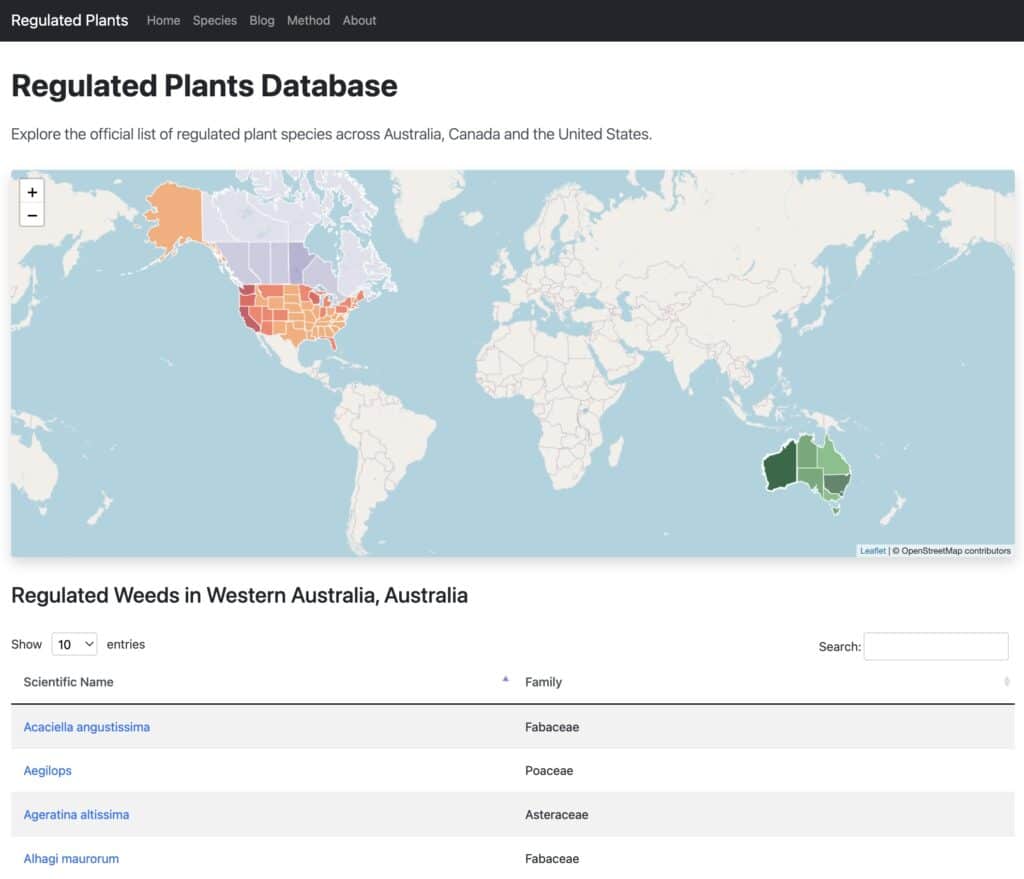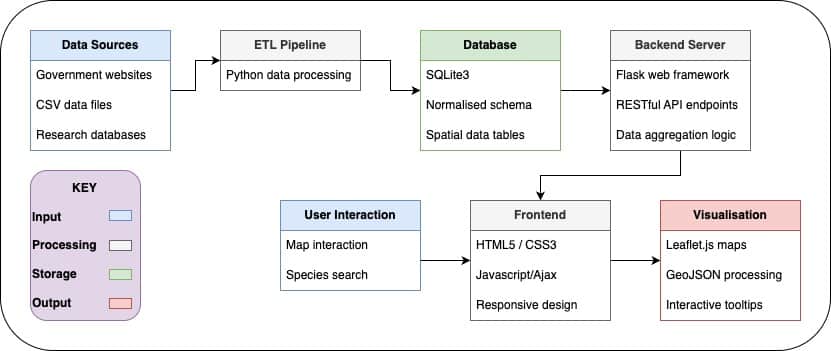Regulated Plants: Geospatial Analytics
A geospatial analytics platform that has transformed environmental compliance research for thousands of users worldwide, now officially hosted by the United Nations University. I led the data visualization and web development, delivering an interactive tool that consolidates fragmented plant regulation data from multiple jurisdictions.
Business Problem
Environmental regulatory compliance requires access to accurate, location-specific data on regulated plant species. However, this critical information is fragmented across numerous government sources, making compliance difficult and research inefficient. Our solution transforms this dispersed data into an accessible, interactive analytics platform.
Solution Overview
We developed a comprehensive database of 1000+ regulated plant species with an intuitive interface that enables two primary analytical approaches:
- Geospatial Analysis: Visualizing regulatory density across states/provinces through interactive mapping
- Species-Based Analysis: Searching by specific plant species to identify all jurisdictions where it faces regulation

Business Analytics Capabilities
Our platform enables multiple levels of analytical insight that serve diverse stakeholder needs:
- Comparative Regional Analysis – Users can instantly compare regulatory intensity across jurisdictions, revealing patterns in regulatory approaches between states and countries.
- Threshold-Based Risk Assessment – Our carefully calibrated color gradient system (thresholds at 100, 150, 200, 250, 300+) provides immediate visual identification of high-regulation areas, supporting risk management decisions.
- Species Concentration Intelligence – The system precisely identifies jurisdictions with the highest concentration of regulated species, helping organizations prioritize compliance efforts.
- Taxonomic Distribution Analysis – When examining specific regions, users can analyze regulated plants by scientific classification, revealing patterns in how different plant families are regulated across territories.
Stakeholder Value
This analytical platform delivers measurable value to multiple stakeholder groups:
- Agricultural Professionals: Identify high-risk regulatory zones to inform cultivation planning and compliance strategy
- Farmers and Landowners: Quickly verify regulatory status of existing or planned plantings in specific locations
- Research Scientists: Target specific regions for comparative studies based on regulatory patterns
- Policy Makers: Benchmark regulatory approaches against neighboring jurisdictions to inform policy development
- Conservation Organizations: Identify regions with heightened focus on invasive species control
By transforming fragmented regulatory data into actionable intelligence, this platform significantly reduces compliance research time while improving decision-making quality across multiple domains.
System Architecture
The system architecture below illustrates our data pipeline from collection to visualization. This architecture supports efficient data processing and delivers responsive analytical capabilities through carefully integrated components:

…
Recognition and Impact
This project has gained significant recognition within international academic and policy communities:
United Nations University Partnership
Our platform is now officially hosted and endorsed by the United Nations University’s Sustainability Nexus Analytics, Informatics, and Data (AID) Programme, featuring prominently in their esteemed AID Tools collection. The project operates under the official UNU domain: regulatedplants.unu.edu
International Policy Forum
Presented findings and policy recommendations at the Dresden Nexus Conference 2025 (Germany), contributing to global discussions on environmental regulation and sustainability analytics.
Academic Institution Adoption
Created in partnership with faculty from The University of California Davis, Department of Plant Sciences, lending academic expertise to the platform’s development.
Global Research Network
This ongoing initiative continues to welcome data contributions from researchers worldwide, building an increasingly comprehensive global database of regulated plant species.
Visit the live platform: regulatedplants.unu.edu
